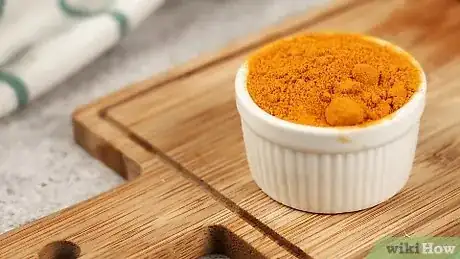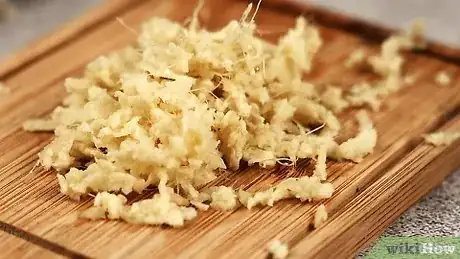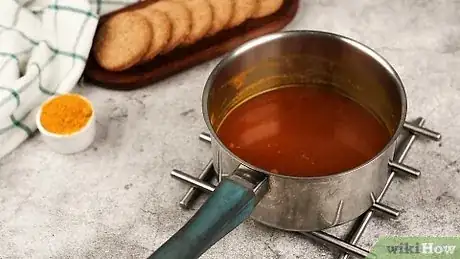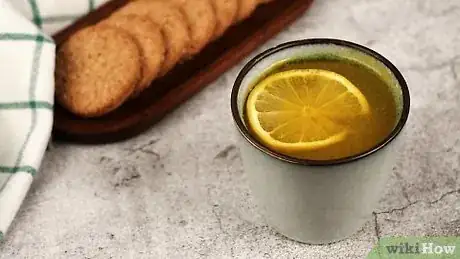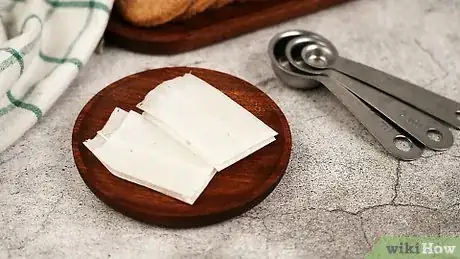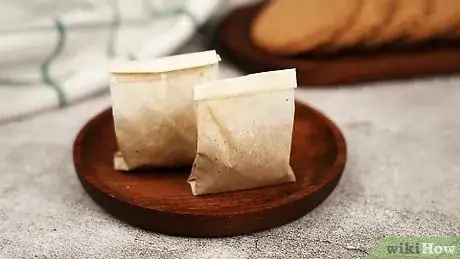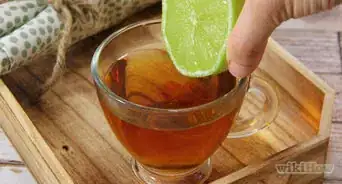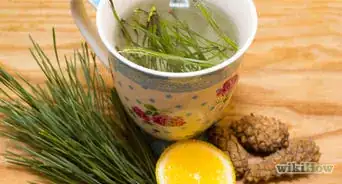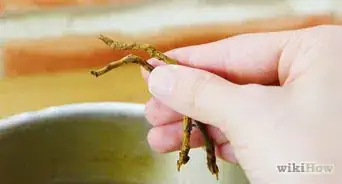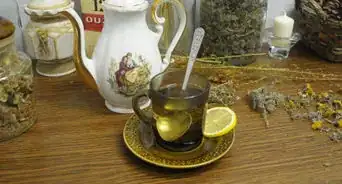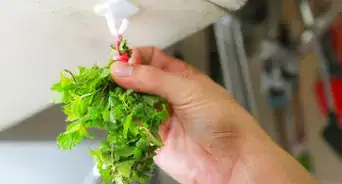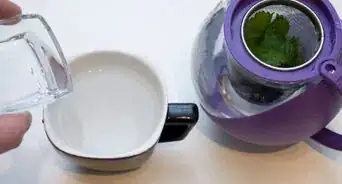This article was co-authored by Erica Docimo, L.Ac., Dipl. O.M.. Erica Docimo is a California and National Certification Commission for Acupuncture and Oriental Medicine (NCCAOM) Licensed Acupuncturist, Herbalist, and the Owner of Mind and Body Acupuncture, a holistic healthcare and lifestyle studio based in Los Angeles, California. With over 15 years of experience, she specializes in Acupuncture, Herbal Prescriptions, and Eastern and Western Nutrition. Erica holds a Masters of Chinese Medicine from The Emperor’s College with a focus on Women’s Health. She also received training at The Academy of Orthopedic Acupuncture (AOA) to become certified in pain reflex-release technique and manual nerve blocking.
wikiHow marks an article as reader-approved once it receives enough positive feedback. In this case, 93% of readers who voted found the article helpful, earning it our reader-approved status.
This article has been viewed 107,705 times.
A natural remedy to combat a variety of illnesses and diseases, turmeric has been revered as one of the best spices throughout the ages. Sprinkle turmeric on your food or use in a soothing tea; turmeric can be taken a variety of ways. For a cold, flu or simply to soothe your soul, create a cup of turmeric tea that will have you saying, “ahhhh” right away.
Ingredients
- 2 cups water
- ½ teaspoon ground turmeric, or 1 inch of fresh turmeric root, minced
- ½ teaspoon dried ginger, or 1 inch fresh ginger (optional)[1]
- ½ teaspoon ground cinnamon or 2-3 cinnamon sticks (optional)[2]
- 10 black peppercorns (optional)[3] [4]
- 1 teaspoon cayenne pepper (optional)
- 2 herbal teabags (optional)[5]
- Honey, to taste
- Small squeeze of lemon or orange juice, to taste
- Milk or alternative milk, to taste (optional)
- Sugar alternative, to taste (optional)
Steps
Preparing the Ingredients
-
1Choose your turmeric. Turmeric has antiviral and antioxidant properties.[6] Ground turmeric is more widely available that the fresh variety. Nonetheless, fresh turmeric can often be found at farmers’ markets, larger grocery stores, health food stores, and Asian markets.
- To mince fresh turmeric, peel it with a small spoon and then grate it on a Microplane or on the smallest holes of a box grater. You can also mince it with a large kitchen knife.
-
2Choose your optional ingredients. Ginger is the most common flavor addition to turmeric tea. Cinnamon is another popular option. Both, like turmeric, are hailed as anti-inflammatories.
- When choosing an herbal teabag, look for lemongrass.[7]
Advertisement -
3Prepare the optional ingredients. Grinding the dried spices will result in more potent flavors.
- Prepare fresh ginger in the same manner as you would the turmeric. Peel it with a spoon. Then, grate in on a Microplane or box grater.
- Cinnamon sticks can be added whole. Or, for a stronger flavor, you can grind them in mortar and pestle or a clean coffee grinder.
- Black pepper can be added whole or ground.
- Cayenne pepper can be added for some extra kick and a small metabolism boost.
Brewing the Tea
-
1Bring the water to a boil in a small saucepan or kettle.
-
2Add the turmeric directly to the boiling water. Add any optional ingredients, except the milk, at this time. If using an herbal tea bag, do not add it yet.
-
3Reduce the heat to low and simmer for 10 minutes. Simmering happens at a lower temperature than boiling. Review the process here: How to Simmer
-
4Remove the saucepan from the heat. Do this carefully. The contents of the pan will be very hot! Use an oven mitt or a folded to kitchen towel to protect your hand.
- Add the herbal tea bag, if using, and let steep for three minutes.
Serving the Tea
-
1Strain the tea. Pour the tea through a sieve set inside a mug or a teapot. This will help remove the solids and yield a smooth tea.
- Use caution when straining the tea. Remember, the liquid is going to be hot.
-
2Add lemon and/or honey. You can do this to the entire batch or, if you’re making multiple servings, let individual drinkers add their own.[8]
-
3
-
4Serve.
Making Turmeric Tea Bags
-
1Gather your equipment. In addition to standard tea brewing equipment like a pot, a kettle, and a mug, you’ll need the following hardware:[11]
- 4 tea satchels. Also known as, tea sachets, loose tea filters, or, simply, tea bags, these are readily available online.
- A small bowl.
- Measuring spoons.
-
2Prepare your ingredients. For this recipe, you will need the following ingredients:
- 2.5 tablespoons ground turmeric
- 1.5 tablespoons ground cinnamon
- 4 tablespoons loose lemongrass tea
- 20 peppercorns
- One-half of a tablespoon is equivalent to 1.5 teaspoons
-
3Mix the ingredients. Place all of the ingredients in the small bowl and stir to combine.
-
4Fill the tea satchels. Use 1 tablespoon of the ingredient mixture per tea satchel.
-
5Brew the tea. Use the standard herbal tea-brewing method: How to Make Herbal Tea
- Consider adding fresh ginger as the tea brews.
- You can also add orange slices and honey.
-
6Gift the tea. These homemade tea bags make great gifts, especially when combined with other tea-making paraphernalia.
Expert Q&A
-
QuestionIs it safe to drink turmeric tea everyday?
 Erica Docimo, L.Ac., Dipl. O.M.Erica Docimo is a California and National Certification Commission for Acupuncture and Oriental Medicine (NCCAOM) Licensed Acupuncturist, Herbalist, and the Owner of Mind and Body Acupuncture, a holistic healthcare and lifestyle studio based in Los Angeles, California. With over 15 years of experience, she specializes in Acupuncture, Herbal Prescriptions, and Eastern and Western Nutrition. Erica holds a Masters of Chinese Medicine from The Emperor’s College with a focus on Women’s Health. She also received training at The Academy of Orthopedic Acupuncture (AOA) to become certified in pain reflex-release technique and manual nerve blocking.
Erica Docimo, L.Ac., Dipl. O.M.Erica Docimo is a California and National Certification Commission for Acupuncture and Oriental Medicine (NCCAOM) Licensed Acupuncturist, Herbalist, and the Owner of Mind and Body Acupuncture, a holistic healthcare and lifestyle studio based in Los Angeles, California. With over 15 years of experience, she specializes in Acupuncture, Herbal Prescriptions, and Eastern and Western Nutrition. Erica holds a Masters of Chinese Medicine from The Emperor’s College with a focus on Women’s Health. She also received training at The Academy of Orthopedic Acupuncture (AOA) to become certified in pain reflex-release technique and manual nerve blocking.
Licensed Acupuncturist & Herbalist As everything, consume it with moderation. Curcumin, the main active ingredient of turmeric, is best absorbed in liquid form which makes for a perfect daily tea ritual!
As everything, consume it with moderation. Curcumin, the main active ingredient of turmeric, is best absorbed in liquid form which makes for a perfect daily tea ritual! -
QuestionWhat is the best way to make turmeric tea?
 Erica Docimo, L.Ac., Dipl. O.M.Erica Docimo is a California and National Certification Commission for Acupuncture and Oriental Medicine (NCCAOM) Licensed Acupuncturist, Herbalist, and the Owner of Mind and Body Acupuncture, a holistic healthcare and lifestyle studio based in Los Angeles, California. With over 15 years of experience, she specializes in Acupuncture, Herbal Prescriptions, and Eastern and Western Nutrition. Erica holds a Masters of Chinese Medicine from The Emperor’s College with a focus on Women’s Health. She also received training at The Academy of Orthopedic Acupuncture (AOA) to become certified in pain reflex-release technique and manual nerve blocking.
Erica Docimo, L.Ac., Dipl. O.M.Erica Docimo is a California and National Certification Commission for Acupuncture and Oriental Medicine (NCCAOM) Licensed Acupuncturist, Herbalist, and the Owner of Mind and Body Acupuncture, a holistic healthcare and lifestyle studio based in Los Angeles, California. With over 15 years of experience, she specializes in Acupuncture, Herbal Prescriptions, and Eastern and Western Nutrition. Erica holds a Masters of Chinese Medicine from The Emperor’s College with a focus on Women’s Health. She also received training at The Academy of Orthopedic Acupuncture (AOA) to become certified in pain reflex-release technique and manual nerve blocking.
Licensed Acupuncturist & Herbalist Simmer ½ cup of filtered water, ½ teaspoon of crushed black pepper, and ¼ cup of turmeric powder in a saucepan, stirring constantly until the mixture reaches a moderately thick paste. Mix a spoonful of turmeric paste with one teaspoon of coconut oil and 8 oz. of hot water to create your turmeric tea.
Simmer ½ cup of filtered water, ½ teaspoon of crushed black pepper, and ¼ cup of turmeric powder in a saucepan, stirring constantly until the mixture reaches a moderately thick paste. Mix a spoonful of turmeric paste with one teaspoon of coconut oil and 8 oz. of hot water to create your turmeric tea. -
QuestionWhat mixes well with turmeric?
 Erica Docimo, L.Ac., Dipl. O.M.Erica Docimo is a California and National Certification Commission for Acupuncture and Oriental Medicine (NCCAOM) Licensed Acupuncturist, Herbalist, and the Owner of Mind and Body Acupuncture, a holistic healthcare and lifestyle studio based in Los Angeles, California. With over 15 years of experience, she specializes in Acupuncture, Herbal Prescriptions, and Eastern and Western Nutrition. Erica holds a Masters of Chinese Medicine from The Emperor’s College with a focus on Women’s Health. She also received training at The Academy of Orthopedic Acupuncture (AOA) to become certified in pain reflex-release technique and manual nerve blocking.
Erica Docimo, L.Ac., Dipl. O.M.Erica Docimo is a California and National Certification Commission for Acupuncture and Oriental Medicine (NCCAOM) Licensed Acupuncturist, Herbalist, and the Owner of Mind and Body Acupuncture, a holistic healthcare and lifestyle studio based in Los Angeles, California. With over 15 years of experience, she specializes in Acupuncture, Herbal Prescriptions, and Eastern and Western Nutrition. Erica holds a Masters of Chinese Medicine from The Emperor’s College with a focus on Women’s Health. She also received training at The Academy of Orthopedic Acupuncture (AOA) to become certified in pain reflex-release technique and manual nerve blocking.
Licensed Acupuncturist & Herbalist Traditionally, turmeric has been consumed with other essential ingredients such as black pepper and healthy fats, to naturally unlock its health benefits and increase digestibility. You can also explore other additions such as honey and plant-based milks to turn your turmeric tea into a golden milk latte.
Traditionally, turmeric has been consumed with other essential ingredients such as black pepper and healthy fats, to naturally unlock its health benefits and increase digestibility. You can also explore other additions such as honey and plant-based milks to turn your turmeric tea into a golden milk latte.
Things You’ll Need
- Small saucepan or kettle
- Fine sieve or a colander lined with cheesecloth
- Cup or a teapot, depending on how much tea you make
- A Microplane or box grater, if using fresh turmeric and/or fresh ginger
Warnings
- Along with its other medicinal properties, turmeric may slow blood clotting. If you’re already taking an anticoagulant, consult your doctor before adding too much turmeric to your diet. In extreme doses, turmeric can also cause stomach pain/upset, indigestion, diarrhea, or even ulcers. [12] [13]⧼thumbs_response⧽
References
- ↑ http://www.thekitchn.com/recipe-turmericginger-tea-104084
- ↑ http://nutritionstripped.com/turmeric-tea/
- ↑ http://nutritionstripped.com/turmeric-tea/
- ↑ http://www.injennieskitchen.com/2014/10/turmeric-tea/
- ↑ http://nutritionstripped.com/turmeric-tea/
- ↑ Erica Docimo, L.Ac., Dipl. O.M.. Licensed Acupuncturist & Herbalist. Expert Interview. 5 October 2021.
- ↑ http://nutritionstripped.com/turmeric-tea/
- ↑ Erica Docimo, L.Ac., Dipl. O.M.. Licensed Acupuncturist & Herbalist. Expert Interview. 5 October 2021.
- ↑ Erica Docimo, L.Ac., Dipl. O.M.. Licensed Acupuncturist & Herbalist. Expert Interview. 5 October 2021.
About This Article
To make turmeric tea, pour water into a small saucepan or kettle and bring the water to a boil. Next, add the ground or fresh turmeric directly to the boiling water, followed by any optional ingredients, like cinnamon, honey, or ginger. Then, reduce the heat to low and simmer the mixture for 10 minutes. Finally, remove the saucepan from the heat and strain the tea through a sieve into a mug or a teapot. For tips on serving the tea with additional flavorings like lemon juice, sugar, and milk, read on!
